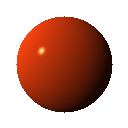Day 7, Casting rays through the whole world
Lots of refactoring today, because old assumptions were smashed, and some cleanup of annoying duplications was needed. No new pixels yet, but maybe tomorrow? These where the previous two days pixel results, with the black background made transparent while converting them from ppm to png.


Casting a ray through the world is as simple as casting it through every object in the world, and collating the resulting intersections.
Next related
Day 8, Making a scene
Further steps toward more pixels, teaching the world to tell what color a ray will see, and creating the necessary transforms for positioning the world in front of the camera. Then have the camera cast a ray, for each pixel in the resulting image, into the world.
Previous related
Day 6, Shadows, Light and Magic
More than just hit detection, we’ve moved into the realm of reflection, lighting and shading. This is mainly about projecting vectors on other vectors, using dot products \(\overrightarrow{v1} \cdot \overrightarrow{v2}\) to measure the length of the projection. For that we need to find normal vectors of surfaces, and a light source.
Day 5, Assume nothing
Today I Learned that I shouldn’t have assumed the sphere would ever need to change from being a unit sphere, so intersecting gets even simpler:
Day 4, Intersections
More math heavy stuff, calculating the positions along a ray, where it intersects a sphere. Turns out this is as simple as solving a quadratic equation, with some special coefficients.